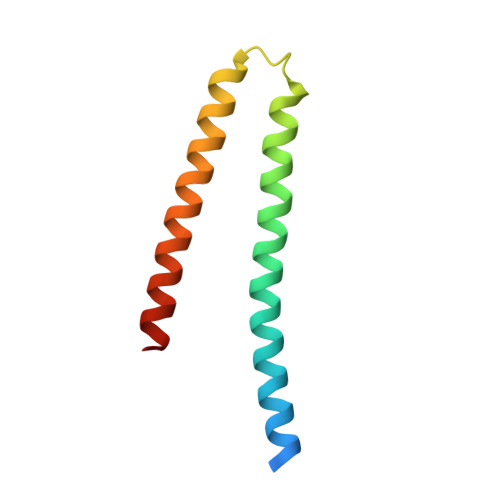A molecular model for self-assembly of the synaptonemal complex protein SYCE3.
Dunne, O.M., Davies, O.R.(2019) J Biol Chem 294: 9260-9275
- PubMed: 31023827
- DOI: https://doi.org/10.1074/jbc.RA119.008404
- Primary Citation of Related Structures:
6H86 - PubMed Abstract:
The synaptonemal complex (SC) is a supramolecular protein assembly that mediates homologous chromosome synapsis during meiosis. This zipper-like structure assembles in a continuous manner between homologous chromosome axes, enforcing a 100-nm separation along their entire length and providing the necessary three-dimensional framework for cross-over formation. The mammalian SC comprises eight components-synaptonemal complex protein 1-3 (SYCP1-3), synaptonemal complex central element protein 1-3 (SYCE1-3), testis-expressed 12 (TEX12), and six6 opposite strand transcript 1 (SIX6OS1)-arranged in transverse and longitudinal structures. These largely α-helical, coiled-coil proteins undergo heterotypic interactions, coupled with recursive self-assembly of SYCP1, SYCE2-TEX12, and SYCP2-SYCP3, to achieve the vast supramolecular SC structure. Here, we report a novel self-assembly mechanism of the SC central element component SYCE3, identified through multi-angle light scattering and small-angle X-ray scattering (SAXS) experiments. These analyses revealed that SYCE3 adopts a dimeric four-helical bundle structure that acts as the building block for concentration-dependent self-assembly into a series of discrete higher-order oligomers. We observed that this is achieved through staggered lateral interactions between self-assembly surfaces of SYCE3 dimers and through end-on interactions that likely occur through intermolecular domain swapping between dimer folds. These mechanisms are combined to achieve potentially limitless SYCE3 assembly, particularly favoring formation of dodecamers of three laterally associated end-on tetramers. Our findings extend the family of self-assembling proteins within the SC and reveal additional means for structural stabilization of the SC central element.
Organizational Affiliation:
From the Institute for Cell and Molecular Biosciences, Faculty of Medical Sciences, Newcastle University, Framlington Place, Newcastle upon Tyne NE2 4HH, United Kingdom.














